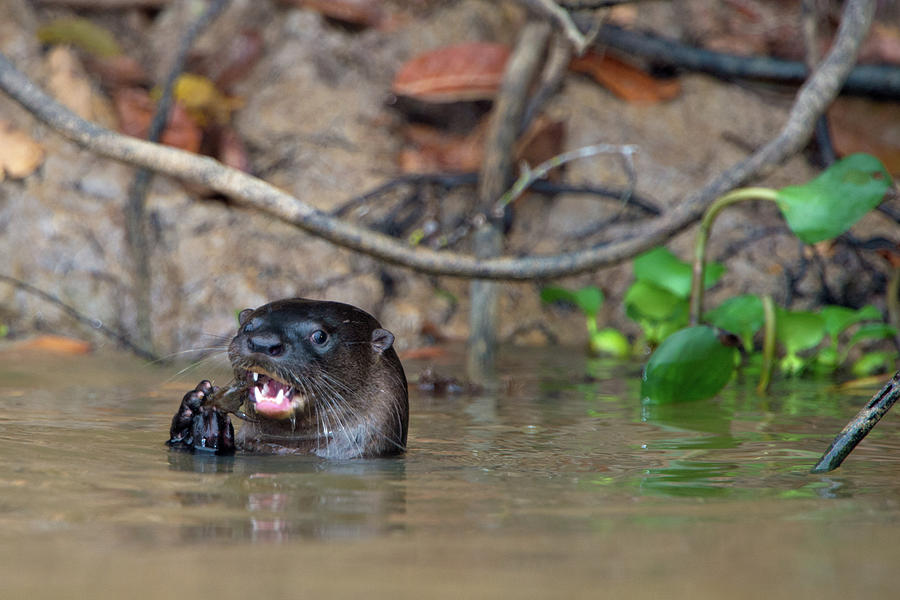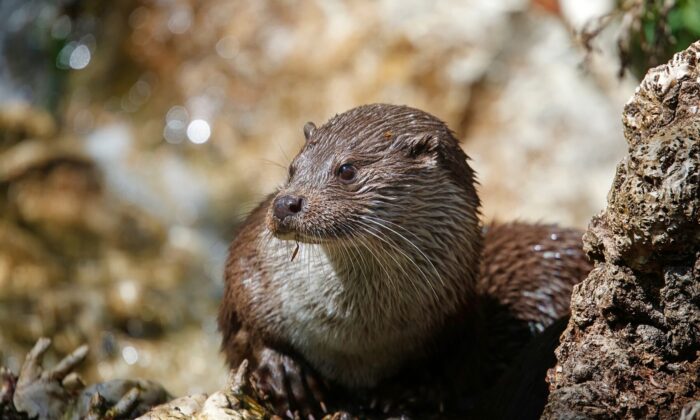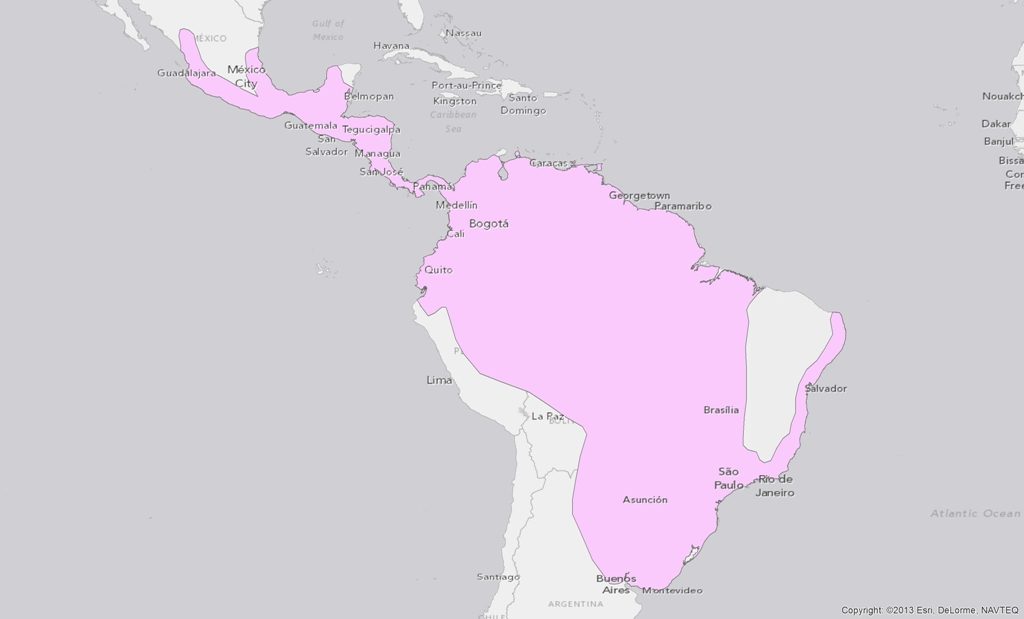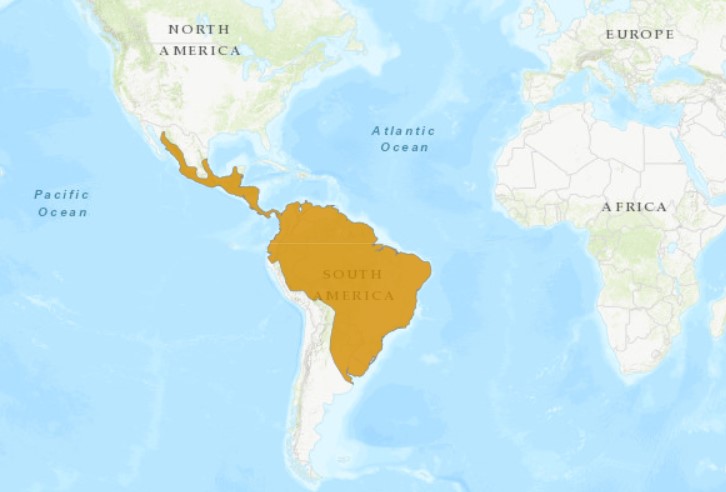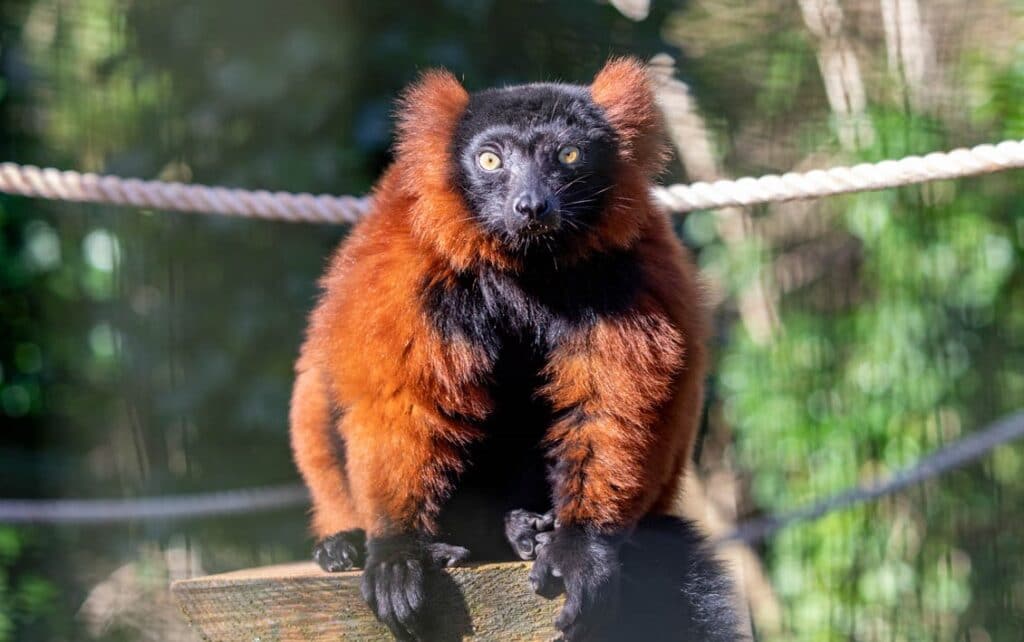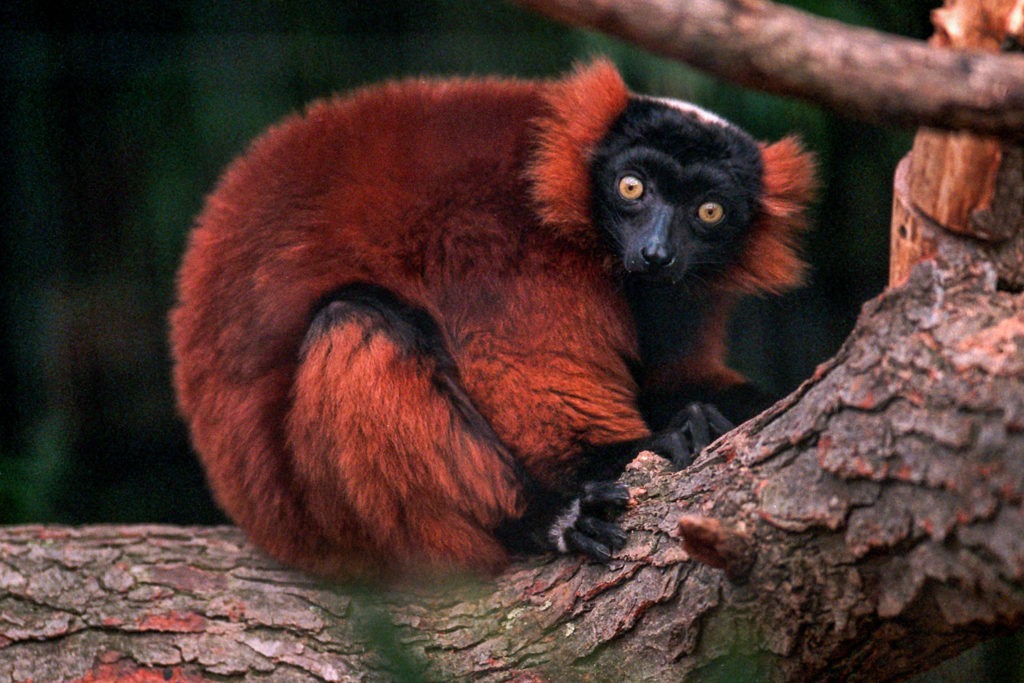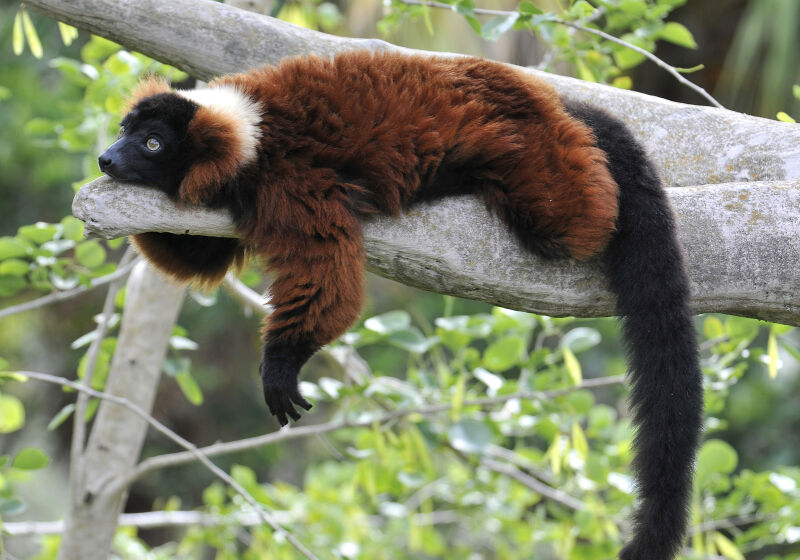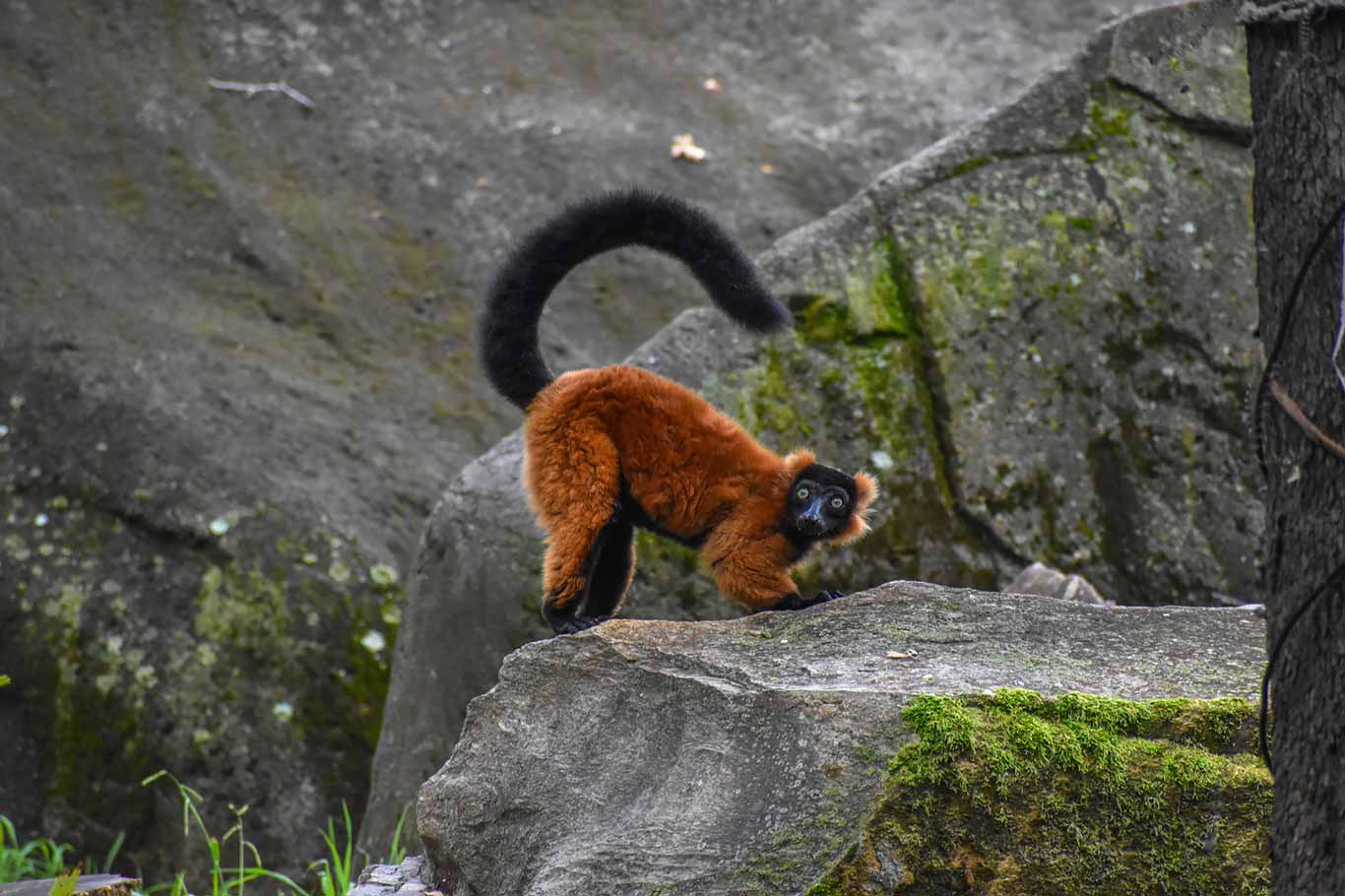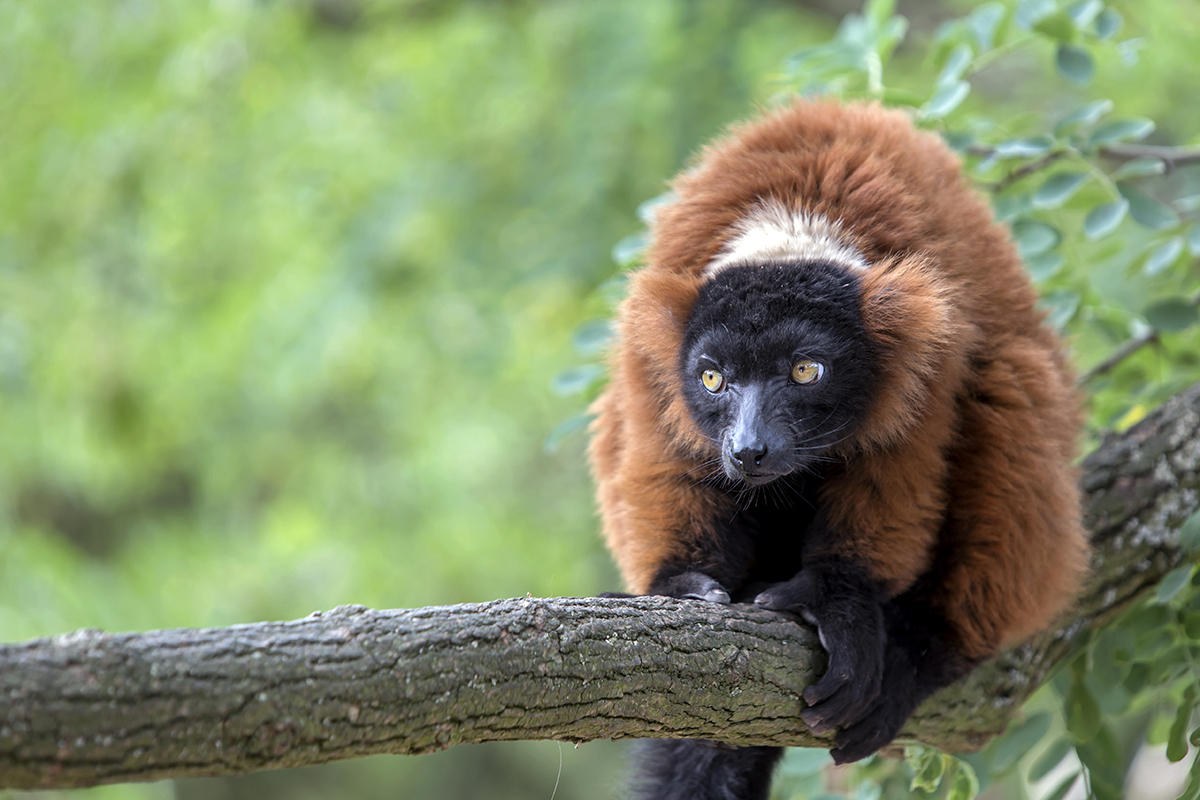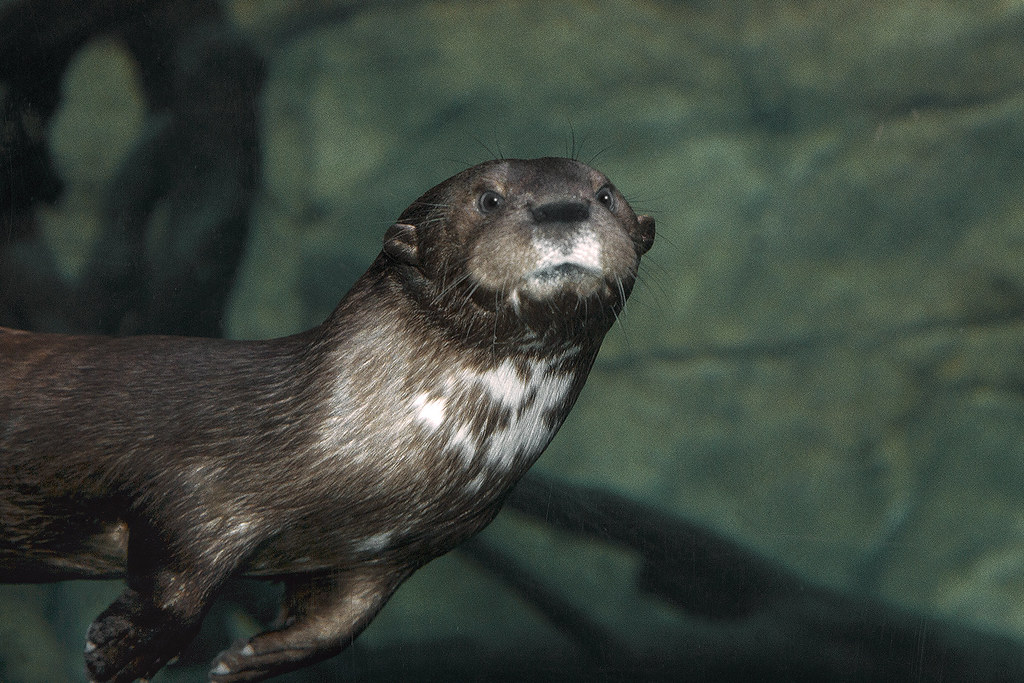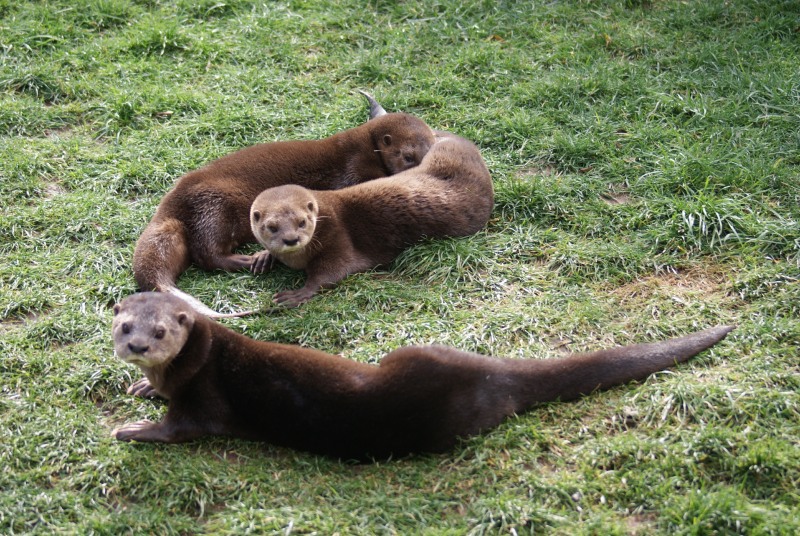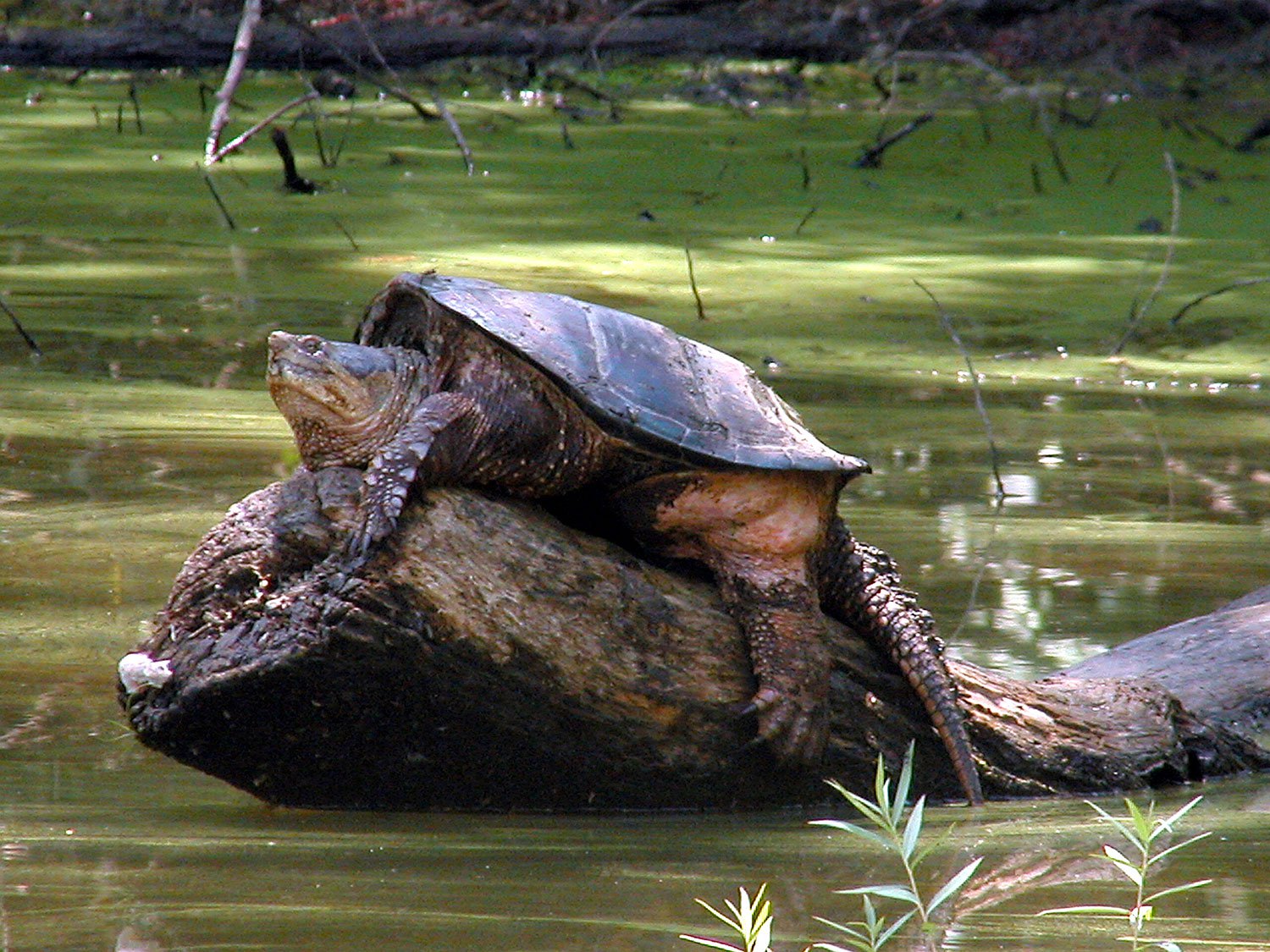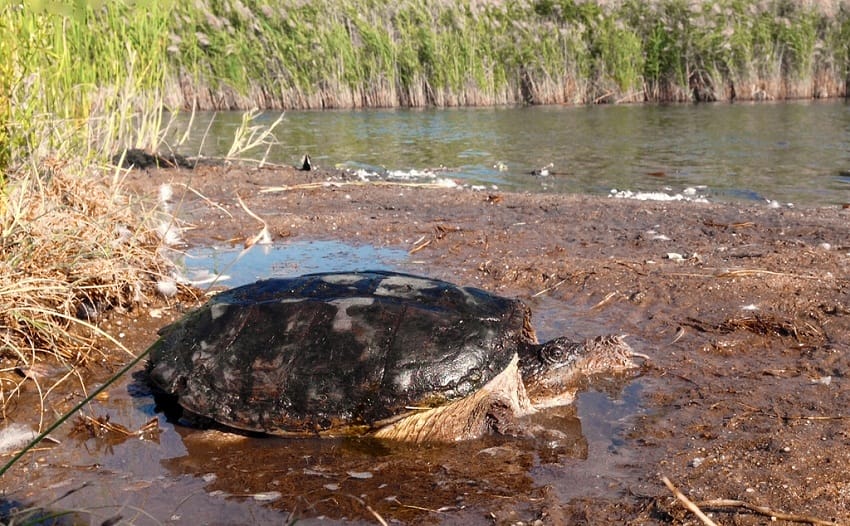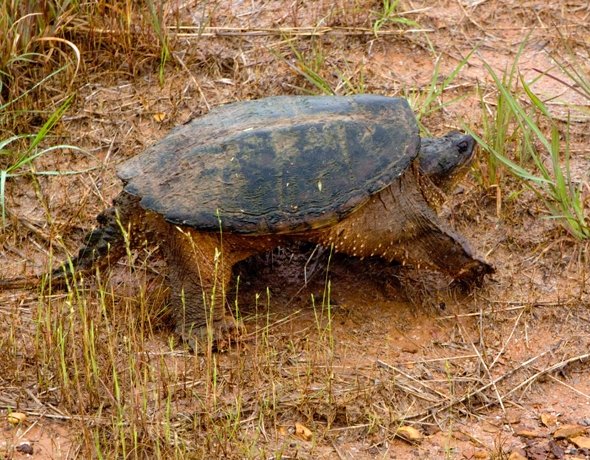
The neotropical otter or neotropical river otter (Lontra longicaudis) is a near-threatened (per the IUCN) otter species found in freshwater systems from Mexico and Central America through mainland South America, as well as the island of Trinidad. It is physically similar to the northern (L. canadensis) and southern river otter (L. provocax),
which occur directly north and south of this species' range,
respectively. Its head-to-body length can range from 36–66 centimetres
(14–26 in), plus a tail of 37–84 centimetres (15–33 in). Body weight
ranges from 5–15 kilograms (11–33 lb).[3]

At the Corrientes Zoo, Argentina
The neotropical otter is found in many different riverine habitats and riparian zones, including those in tropical and temperate deciduous to evergreen forests, savannas, llanos (of Colombia and Venezuela) and the pantanal (in Bolivia, Brazil and Paraguay). It prefers to live in clear, fast-flowing rivers and streams, preferably away from competition with the more boisterous giant otter (Pteronura brasiliensis).
Unlike other otters (including the aforementioned giant species), which
live in large and cohesive socio-familial units, the neotropical otter
is a relatively solitary animal, feeding mostly on fish and crustaceans.
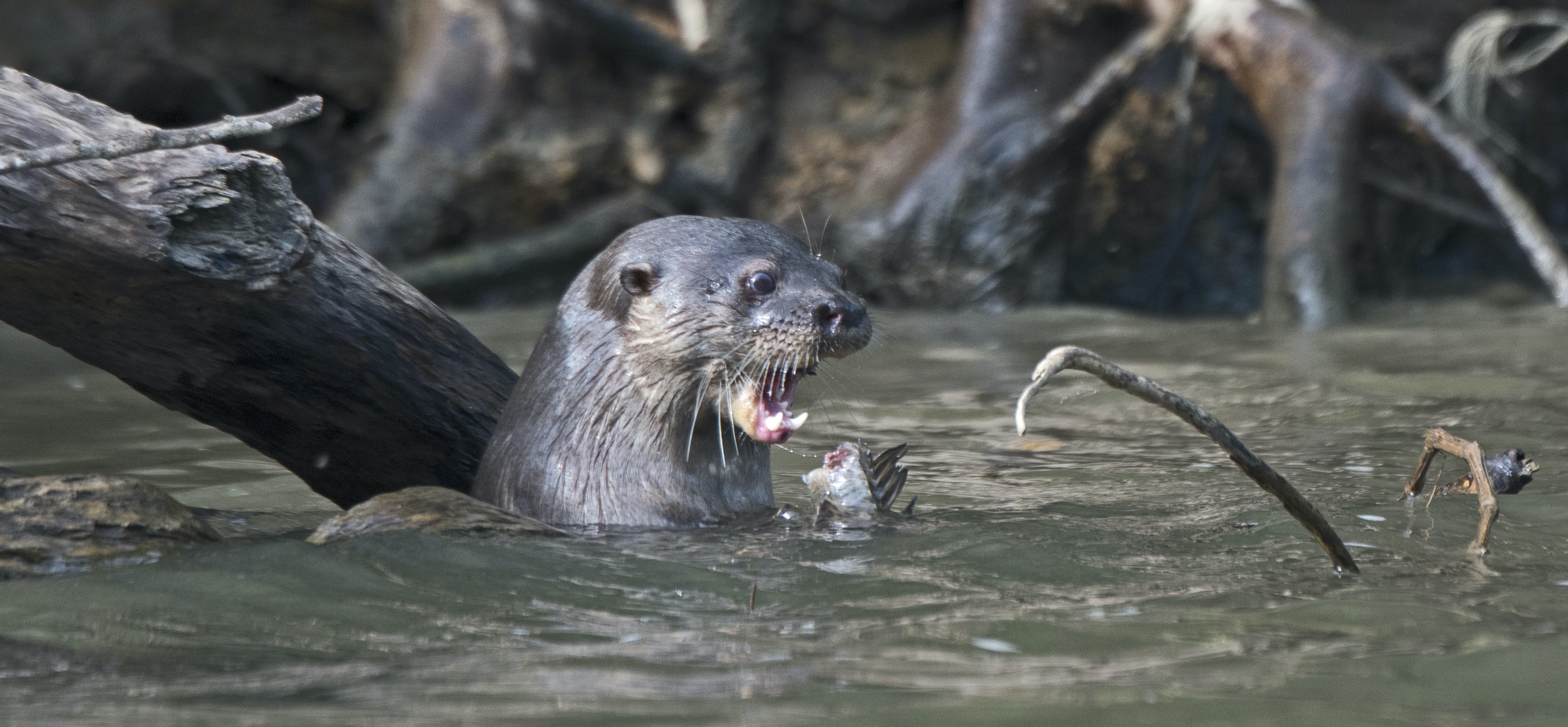
The taxonomy of the genus Lontra has been debated, but the use of Lontra rather than Lutra
for New World otters is generally supported. The Neotropical otter has a
very wide range, covering a large portion of South America, so it is
not surprising there are geographical structures separating some
populations. One such geographical isolation is the Cordillera
Mountains. Additionally, the river in the Magdellena river valley flows
north, away from the mountains, decreasing the likelihood that otters in
the northern tip of South America will mix with otters elsewhere in the
continent.
Neotropical otters have an unusual phylogenic relationship to other otter species. They are most similar to marine otter (Lontra felina) and southern river otter (Lontra provocax),
which is not surprising considering these two species are found in
South America. However, Neotropical otters are relatively distantly
related to giant otter (Pteronura brasiliensis), which is surprising considering they have nearly identical ecological niches and home ranges.[4]
In one study, otters within a 1,600 sq mi (4,100 km2)
area in southern Brazil showed low nucleotide variation, but high
haplotype diversity compared to other otter species and other
carnivores. The study made the conclusion that otters may be undergoing a
recent increase in diversity. The results also show interrelatedness of
otters nearby and give reason to separate the species into subspecies:[5]

The Neotropical otter is covered in a short, dark grayish-brown pelage. Fur color is lighter around the muzzle and throat.[6] They possess a long wide tail, with short stout legs and fully webbed toes. Sexually dimorphic, the males are about 25% larger than the females.[7] Its head-and-body length can range from 36–66 centimetres (14–26 in), plus a tail of 37–84 centimetres (15–33 in).[3]
Body mass of the otter generally ranges from 5 to 15 kilograms (11–33
pounds). Neotropical otters will communicate with nearby otters via
scent marking. Communication may also occur via whistles, hums, and
screeches.[7]
The dental formula seldom varies from that of Eurasian otters (Lutra lutra), except in the few cases of otters that have dental anomalies.[8] Females and males have the same formula. The dental formula (for half the skull) is as follows:[9]

A neotropical otter in Bioparque Ukumarí, Colombia
The Neotropical otter has the widest distribution of all the Lontra
species. Their habitat can range from northwest Mexico to central
Argentina. They prefer clear, fast-flowing rivers, and are rarely known
to settle in sluggish, silt-laden lowland waters or boggy areas. While
mostly occurring at 300–1,500 m (980–4,900 ft) above sea level, they
have been found settled at 3,000 m (9,800 ft).[10]
They require dense riparian vegetation and abundant den sites but,
other than that, the Neotropical otter is very versatile and tolerant to
environmental change. The otters prefer den sites that are solid, high,
dry, and in proximity to deep water.[11]
The Neotropical otter is the greatest generalist of all otter species.
In addition to rivers and streams, they can settle in and exploit some
rather formidable habitats, such as wastewater treatment plants, rice
paddies, sugar cane plantations, estuaries, deltas, drainage ditches,
and sometimes swamps. They can inhabit cold, glacial lakes and streams
in the Andes of Ecuador and Colombia.[12] Neotropical otters will also venture to the seashore and beaches (maintaining an almost "brackish" lifestyle), hunting marine creatures and playing in the highly saline water.[13]

The
Neotropical otter's diet consists mostly of fish and crustaceans making
up 67% and 28%, respectively, of its total diet. The otter will also
occasionally feed on mollusks and small mammals, as well as birds, large
insects and fruits.[14][15] In areas where fish and crustaceans are scarce, aquatic insects, such as dobsonfly larvae, can become its main prey.[16] This otter is known to occasionally attack fishnets for a source of prey, hindering fishing productivity.[13] Otters living near marine habitats can have a much higher proportion of crustaceans in their diets.
Seasonality also greatly affect otters' food choice. During the
dry season, when less fish and crustaceans are available, one study
found a higher proportion of frogs in otters' diet. Though, during this
time, anurans and reptiles still made up a very small percentage of the
total diet. This might also be due to the fact that certain frogs mate
during the dry season, so the frogs are easier prey. All in all, the
distribution of available food species in a particular area roughly
correlates to the percentage of each species found in otters' diet.[17]
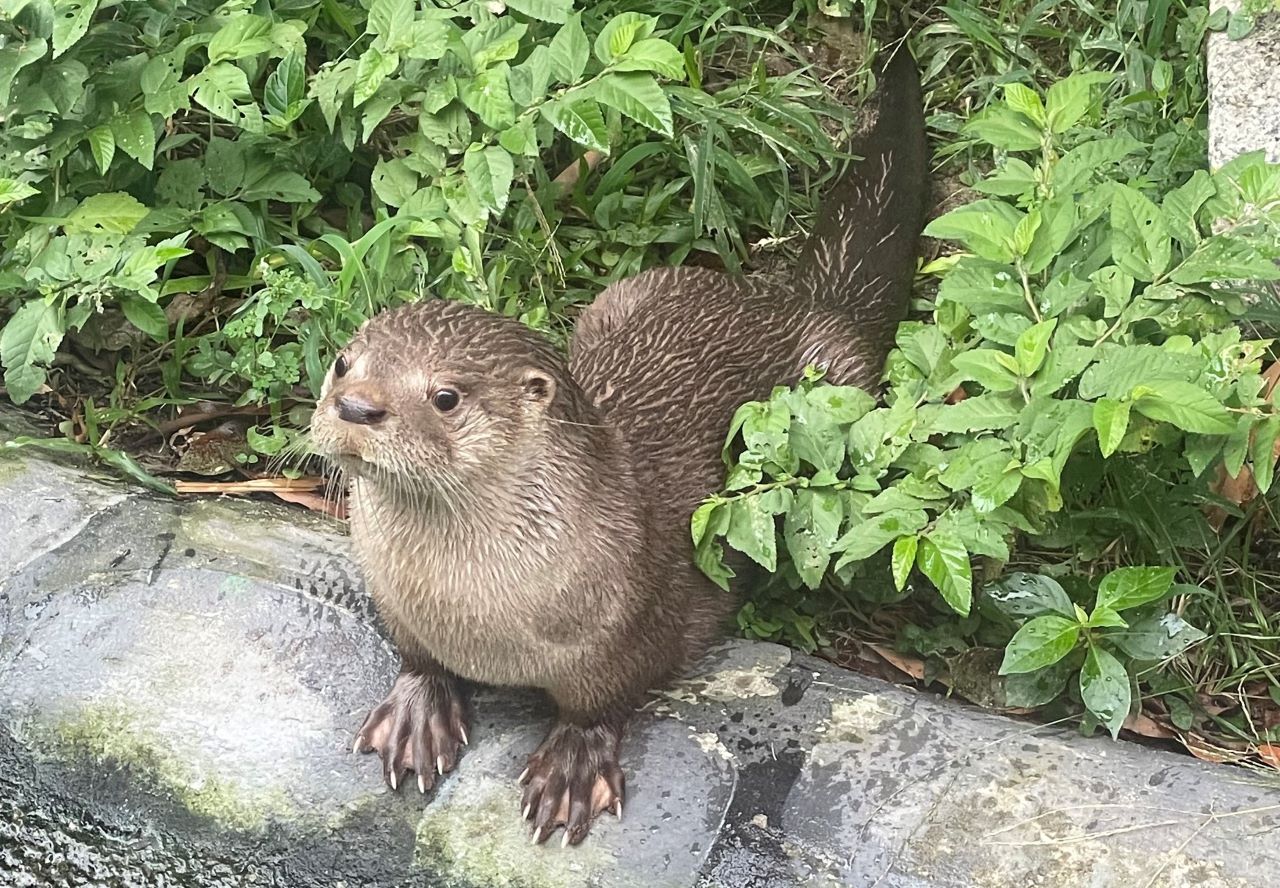
Breeding occurs mostly in spring. Gestation will last 56 days and produce a litter of 1–5 pups.[6]
The pups are born blind yet fully furred. They will emerge from their
mother's nest when about 52 days and begin swimming at 74 days. They are
raised completely by their mother, as males do not provide any parental
care.[11]
The male will only spend a single day with the female during breeding
season. The female must keep her pups safe from predation by other
Neotropical otters. In one captive breeding situation, cannibalism by
the mother may have occurred, though it was not confirmed.[18]

In an ecologically healthy area, there are many possible shelters
so an individual can choose its preferred den. However, studies show
that not all possible shelters are occupied and not all shelters are
equally utilized by Neotropical otters. Otters visit different shelters
with varying frequencies, from once or few times per up to many times
per year. One factor that influences their preference for a den has to
do with the water level, especially during flood season, when a den near
water level can easily be washed away. A den may be at the water level,
near the bank, or more than 1.5 meters about the water level.[19]

There are many other factors influencing otters' preferences for a
shelter. Neotropical otters prefer dens near fresh water, high food
availability, and relatively deep and wide water. During seasons with
low water, individual otters may be more clumped because they will all
move into areas of a river with deeper water, with more fish.[19]
Deep, wide pools have been found to have a greater diversity of fish,
preferential for otters. Some studies show that otters will forgo a less
preferable, but more available den, like a muddy river bank, to spend
more time in a preferential den, like a rocky shore.[20]
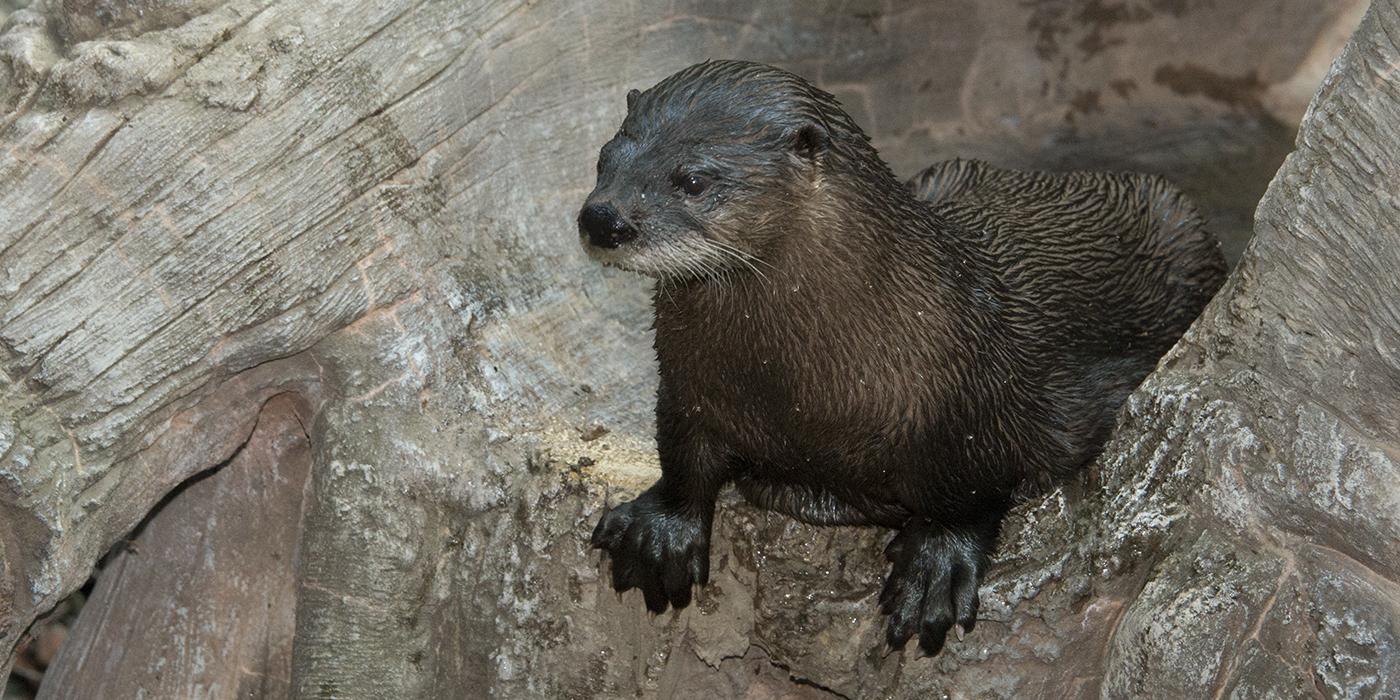
Neotropical otter females will rear pups in a den without a male.
In some cases, a female may find a den that has space to keep her pups
and a separate area for her own space. A study of a male otter's
movement over 35 days showed he used three different dens without
communication between them. Also, this individual moved between two
islands separated by a one-kilometer wide estuary. He spent some time in
a site with heavy mud, poor substrate for a den, so he may have been on
the move to find food.
[21]

Dens may have more than one opening, so the otter can easily exit
to forage for food while staying safe from predators. There are many
classifications of dens that Neotropical otters may use. A cavity among
stones or under tree roots is preferred. In certain parts of South
America, an otter may come across a limestone dissolution cavity or a
cavity in a rocky wall. Though lacking a source of light, the
Neotropical otter can make great use of this sturdy home. As a last
resort, an otter expend energy to excavate a space among vegetation or a
river bank, though those homes are less sturdy. Vegetative cover is
also very important for the Neotropical otter. In comparison to other
otter dens, the Neotropical otter dens do not have holes directly into
the water, they do not use plant material as bedding, and will live in
caves without light. They are elusive creatures and prefer undisturbed
forests without signs of human activity. When humans clear forests for
agricultural land, the number of available otter habitats plummets.[19]

Like
other otter species, Neotropical otters will mark their territory with
scratching or spraint (feces) in obvious places like rocks and under
bridges.[22]
Signs of marking may be most concentrated around their dens. They tend
to only mark in certain areas of the den, separate from the activity
center of the den. In caves, where a water sources may leak through the
walls and wash away the scent, the resident may mark areas inside their
den.[19]

The
niches and ranges of the giant otter and the Neotropical otter overlap
widely. Both species are diurnal and mainly piscivorous. The giant otter
is less of a generalist in habitat, preferring slow-moving water and
overhanging vegetation, but where the Neotropical otter may also occur.
The giant otter is much larger and hunts in groups, so it can take
larger prey. Some areas, like the Pantanal, have high enough
productivity such that both otter species can coexist with little or no
competition (niche partitioning). Additionally, Neotropical otters prefer deeper and wider streams than giant otters.[12]
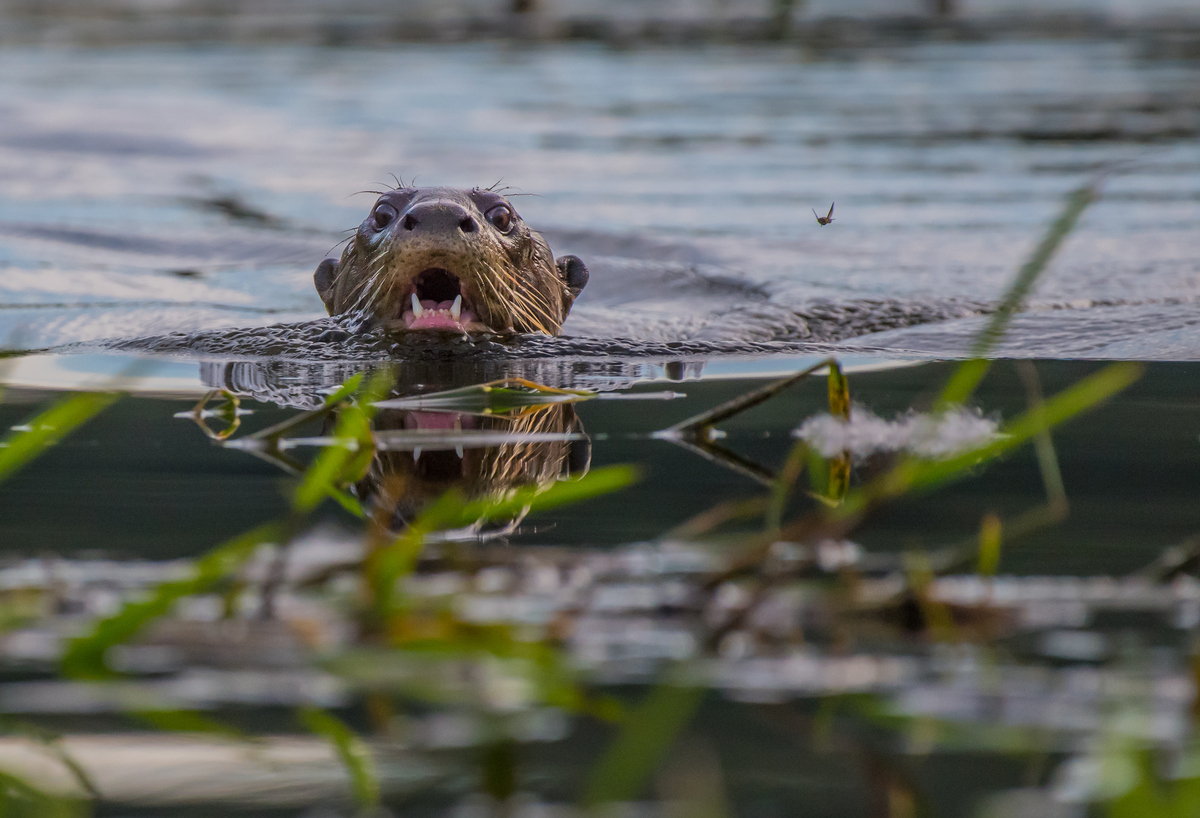
The Neotropical otter is listed as Near Threatened by the IUCN.
The species is currently protected in Argentina and many other South
American countries. Heavy hunting for its fur in the 1950s–1970s
resulted in much local extinction over the otter's range. Illegal
hunting, habitat destruction through mining and ranching, and water
pollution still affect the population of the Neotropical otter.[23] Although there have been attempts at captive breeding, these attempts have been largely unsuccessful.[6]

Most negative feelings about otters arise from fishermen who
compete with the otter for fish. More data is needed to determine how
much overlap exists between the fishermen's desired catch and the
otter's diet. The highest competition between Neotropical otters and
fishermen occurs during drought conditions. Fishermen may move out of
their regular fishing areas, into deeper pools where the otter usually
hunts in the absence of people. In a study on local fishermen's
attitudes, the study revealed that fishermen's knowledge aligned with
scientific data about the Neotropical otter's behavior, body
description, and other data. Because the fishermen's facts aligned with
scientific knowledge, scientists could then trust the fishermen's
first-hand accounts about problems they experience with otters.
Fishermen reported that otters will damage their fishing gear, but do
not damage crab and shrimp nets. The locals have varying opinions about
the otters' presence, from understanding they have to share space with
the otters to wanting to kill the otters. There have been proposals to
subsidize their fish profits lost to otters. However, it might be more
beneficial to pay them to collect data on the species. This would
benefit fishermen economically, improve fishermen's attitude towards
them, and build on to currently insufficient data about this species.
Otters are rarely get caught in gillnets, and when they do they very
rarely die.[24]

Neotropical otters are threatened by habitat degradation associated with: agriculture, soil compaction, pollution, roadways, and runoff.
Also, when forests are cleared for cattle grazing, heavy vegetation
(which is the otter's preferred habitat) near streams is also cleared or
trampled by cattle. This species is a very important ecological
indicator because they prefer ecologically rich, aquatic habitats and
have a low reproductive potential.[20]

One male and one female Neotropical otter were captured near Caucasia, Colombia, and taken to Santa Fe Zoological Park
in 1994 and 1996, respectively. Zoo staff observed the pair mating in
the water, then separated the animals. The female had three births; one
was successful. The infant deaths may have been unintentionally caused
by the mother. One idea suggested the mother's enclosure was too small
and she had no access to water, as she would have had in the wild. The
mother's gestation period was 86 days for two separate breeding events
recorded at this zoo. An 86-day gestation period is much longer than the
previously accepted belief that gestation lasts around 60 days. Two
possible explanations are: differences might exist between different
subspecies or a later copulation may have occurred and not been
observed. Also, this otter species might display short-term variation in
gestation periods.[18]
